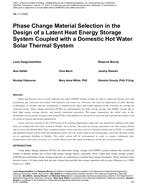Description
Home and business users of solar domestic hot water (SDHW) heating systems are able to reduce the energy costs and greenhouse gas emissions associated with domestic hot water use. However, the level of deployment of solar thermal technologies, as retrofits and new installations, is limited by the space and weight imposed on the structures for storing the collected energy. Phase change materials (PCMs) are advantageous for daily energy storage with SDHW systems due to their high energy storage density, and mainly isothermal operation. This paper summarizes the initial steps in the development of an energy storage system using PCMs, with emphasis on the material selection and experimental studies used for proof of concept and design optimization.
Lauric acid was selected as the PCM based on the melting temperature range that was targeted by studying solar data from an existing solar hot water system in Halifax, Nova Scotia. The proof of concept experiment was done using a finned tube to carry the thermal fluid; these extended surfaces were used due to the low thermal conductivity of PCMs. A validated and optimized design will be built and installed by early 2011 for a pilot study in an existing large scale solar thermal system on an apartment building in Halifax. The entire system will be instrumented in order to acquire continuous data (temperatures, flow rates, pressure, etc.) to fully characterize the system and improve on this first tested prototype.
Citation: ASHRAE Conference Papers, Montreal, QC
Product Details
- Published:
- 2011
- Number of Pages:
- 8
- File Size:
- 1 file , 960 KB
- Product Code(s):
- D-ML-11-C023




